Still regarded by many fans as Mario's finest 2D adventure to date, it's remarkable to think that Super Mario World was a launch title for the SNES; few other platformers on the console came close to matching its excellence.
Boasting a huge world map which could be tackled in a variety of ways (and a dazzling number of individual levels) as well as new power-ups and the famous Yoshi, Super Mario World is arguably the benchmark by which all 2D platformers were judged back in the early '90s; Sega's Sonic arguably looked and sounded better, but it wasn't a match for Mario's 16-bit debut in terms of pure gameplay.
Another early SNES release, Link to the Past built on the first two NES titles to create an action-adventure which still stands proud in the Zelda canon, despite its age. The gorgeous visuals, excellent music and engrossing challenge make this an all-time classic; it's hard to recall a game of this type which fits together so effortlessly.
Dungeons boast challenges which are only solvable using newly-acquired items, while the vast, sprawling overworld actively encourages exploration. Then, just when you think you've seen it all, the game offers up an entirely new world to explore – a revelation which remains one of 16-bit gaming's biggest shocks. The GBA port is also worth a look, and the game has been re-released fairly regularly over the years.
One of the most idiosyncratic RPGs ever made – and, according to director Shigesato Itoi, the first RPG that Shigeru Miyamoto ever completed – EarthBound takes the conventions of the genre and gleefully subverts them in ways that are still refreshing, even after all these years.
Set in the nation of Eagleland – which is basically a parody of the United States – EarthBound places you in the role of Ness, a young boy who unearths a plot by an alien race to take over the world. While it sold poorly in the west, EarthBound's cult status has grown significantly over the years, and it is now considered one of the SNES' most accomplished titles.
It's part of the Nintendo Switch Online subscription service, which will save you quite a bit of cash as the original release is very expensive these days.
While the notion of fusing genres might not seem all that odd today, back in the early 1990s it was most certainly unusual – but ActRaiser pulled it off with aplomb, creating one of the most memorable SNES releases of the console's formative years. Part action platformer, part 'Populous' -style God Sim, the game places you in the role of a deity who seeks to reclaim the faith of his people.
This is achieved by first removing enemies in a side-scrolling action section before taking to the skies and marshalling your followers as they expand their settlements and seal off enemy lairs. Each region offers a different challenge, while Yuzo Koshiro's sublime soundtrack fits the on-screen action like a glove. A sequel was also forthcoming, but it foolishly did away with the God sim sections and is an inferior game as a result, despite boasting some incredible graphics.
More recently, the game was remade for modern systems and is well worth a look.
It's easy to forget today the mild scepticism that surrounded the release of the original Super Mario Kart ; at the time, it felt like Nintendo was trying to shoehorn the character into too many games, and the idea of Mario and his pals tearing up race tracks seemed, for some, like a bridge too far.
However, this wasn't some lazy attempt to generate sales based solely on a brand name – Super Mario Kart remains a supremely playable title, and while subsequent iterations of the game have added in visual complexity and additional gameplay quirks, there's something about the simplicity and purity of this one that makes it fun to return to, even decades later. Oh, and the battle mode still rocks.
FIFA true connoisseurs of the sport will have been playing Konami's take back in the '90s. International Superstar Soccer has its roots in the Japanese Jikkyō World Soccer series and offered a much slicker and fast-paced alternative to EA's franchise.
The introduction of a spring button in the first ISS was a game-changer, while the crystal-clear speech was a close to 'real' commentary as you were likely to get back on cartridge-based consoles. ISS Deluxe also saw the return of the original game's unique 'scenario' mode which placed you in various matches – often based on real-world encounters – with the aim of reversing the scoreline or winning with only a fraction of time remaining on the clock.
ISS would spawn several sequels before Konami eventually shifted its attention to its incredibly popular Pro Evolution Soccer
Known in Japan as Assault Suits Valken , this side-scrolling action title offers a unique alternative to the intense 'run and gun' antics of Konami's Contra , because this time around, you're piloting a hulking robot which is blessed with a convincing sense of weight and inertia.
Inspired by the likes of Mobile Suit Gundam , Cybernator is a relentlessly polished experience with top-level visuals, sound and gameplay – all wrapped up in a wonderfully dramatic storyline. Assault Suit Leynos Target Earth in the west) is part of the same series, and Valken would get a Japan-Only PlayStation sequel in 1999 which adopted a turn-based strategy approach.
Up Next: Best Nintendo 3DS Games

